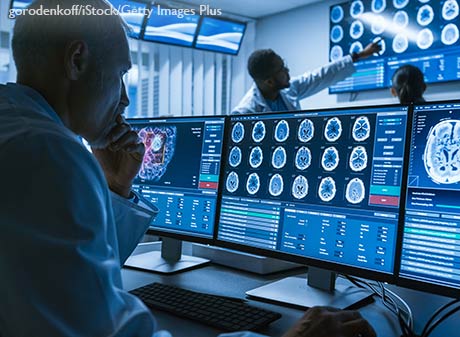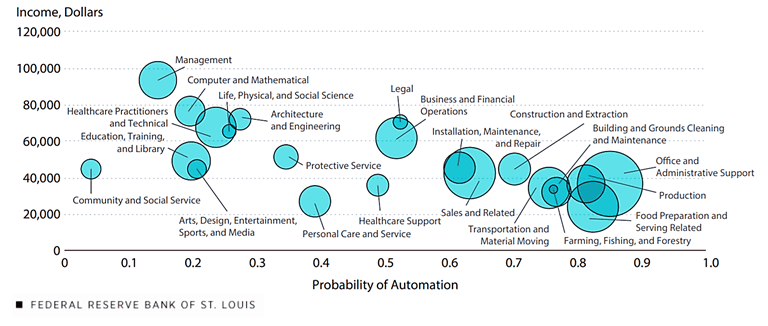Workplace Automation: Should We Fear the Robots?

Science fiction has given us plenty of negative portrayals of robots, from “Ex Machina” to “The Terminator” films. In real life, St. Louis Fed researchers are separating fact from fiction when it comes to automation’s impact on jobs.
Science fiction has not been kind to the robot.
For every sympathetic depiction of a robot (remember “WALL-E”?) many more are negative (think “Ex Machina”).
One reason for such dismal depictions may be our own fear that rapid technological advances could overwhelm and possibly replace us — perhaps not in the way Skynet tries to eliminate humanity in “The Terminator” films, but by the steady displacement of humans in the workplace.
The worry isn’t just fodder for science fiction. In a 2017 interview with Quartz, Microsoft co-founder Bill Gates talked about imposing taxes on robots as one way to deal with the long-term effects of automation on employment.
Even the European Parliament considered a robot tax on owners, though it eventually declined to pass one.
So are we edging closer to a "robocalypse" when it comes to jobs?
Researchers at the St. Louis Fed have been studying how robots and other forms of automation may affect the labor market, sorting out truth from fiction.
Where Are the Robots?
Writing in the Regional Economist, St. Louis Fed Economist Maximiliano A. Dvorkin and Research Associate Asha Bharadwaj examined the rapid growth of robots used in factories and other industrial settings.
The number of industrial robots is still small relative to the overall U.S. workforce, with 1.79 robots per thousand workers in 2017.
And the U.S. isn’t even the biggest user of industrial robots: Germany had more than double that ratio in 2017, as shown in the figure below.

However, Dvorkin and Bharadwaj noted that the use of robots has grown rapidly in recent decades. That U.S. ratio (1.79) is more than triple the number in 1995, when it stood at 0.49 robots per thousand workers.
That ratio was even larger when you look at specific industries.
For example, the authors found that the biggest U.S. user of industrial robots is the automotive industry, where there were 136 robots per thousand workers in 2017. For all other U.S. manufacturing industries, the ratio was only 8.6 robots per thousand workers.
Vulnerable Jobs?
Economists are working to estimate how robots are affecting the U.S. labor market. But it’s difficult to gauge the overall impact.
“Some workers in the automotive industry, possibly those conducting more manual and routine tasks, may be experiencing job losses as more and more of these jobs are automated by the use of robots,” Dvorkin and Bharadwaj wrote in their article.
“On the other hand, it is also possible that robots raise overall productivity and efficiency, leading to an increase in the demand for other types of jobs that are more complementary to the use of robots, like technicians,” they said. “In addition, it is also possible that other industries benefit from these productivity spillovers and in turn increase their own demand for labor.”
Using a methodology devised by Daron Acemoglu of MIT and Pascual Restrepo of Boston University (PDF), Dvorkin and Bharadwaj looked at the link between industrial robots and employment in routine manual jobs — which include construction, transportation, production and repair jobs — in 722 commuting zones in the U.S. from 1990 to 2007.
("Commuting zones" are geographic units that combine counties into an area that Dvorkin and Bharadwaj believe reflects the concept of a local labor market better than a metropolitan statistical area does.)
They found that an increase in the exposure to robots by one unit per thousand workers is associated with a decline in the commuting zone’s ratio of routine manual employment to population by around 0.12 percentage points.
“In other words, the analysis suggests that the larger increase in the use of robots in some commuting zones may be reducing the number of people employed in routine manual occupations relative to population in those commuting zones,” the authors wrote.
They noted, however, that they could not pin down the aggregate effects of automation on jobs based on this finding alone.
“It may be possible that automation leads to an overall increase in employment, with the increase being lower in commuting zones with higher exposure to robots due to relatively fewer routine manual jobs,” they wrote.
The Broader Impact of Automation

With the growth of AI, automation is expanding well beyond the manufacturing sector. St. Louis Fed researchers note that pre-trial research and medical diagnoses are among “thinking” skills that are becoming automated.
The use of robots is expanding beyond its traditional footprint, the manufacturing sector.
For example, retail giant Walmart announced earlier in 2019 that it was expanding the use of robots for everything from cleaning floors to scanning items on store shelves for price accuracy.
With the growth of artificial intelligence, other forms of automation are also becoming more common. Pre-trial research, handwriting analysis and medical diagnoses are among the “thinking” skills that have begun to become automated, Dvorkin and Bharadwaj noted.
How far will automation spread?
In a 2018 Regional Economist article, St. Louis Fed Economist Sungki Hong and former Senior Research Associate Hannah G. Shell examined the vulnerability of occupations to automation within the Eighth Federal Reserve District—an area covering all of Arkansas and parts of Illinois, Indiana, Kentucky, Mississippi, Missouri and Tennessee.
They used a methodology devised by Carl Benedikt Frey and Michael A. Osborn (PDF), both at Oxford University, to estimate the risk of particular jobs becoming automated. Frey and Osborne calculated that 47% of U.S. jobs are at risk of becoming automated in the future.
Hong and Shell took that analysis and recalculated the possible impact using employment data for 2017. Their results were sobering: Hong and Shell found that 57% of U.S. jobs could be automated, while 60% of jobs in the Eighth District have the potential to be automated in the next two decades.
When they looked at metropolitan statistical areas (MSAs) within the Eighth District, they found the impact of automation could be more heavily felt in the smaller MSAs; these MSAs tend to have more employment concentrated in sales, production and food preparation jobs, which are ripe for automation.
However, this doesn’t mean that 60% of the Eighth District jobs could be lost because of automation, Hong and Shell cautioned.
To estimate possible job loss, they noted that other factors would also need to be taken into account, such as whether:
- A displaced worker can easily find a new job in another industry
- The research and development cost needed to automate a job would be cheaper than the cost of labor
Later, during a St. Louis Fed podcast interview, Hong also pointed out that the automation risk probabilities for occupations don’t take into account how the labor market will respond to automation over time.
“In the long run, maybe workers … would invest in more human capital that is more related to the social intelligence or the creative intelligence that is harder [to be] replaced by the robots,” Hong said. “So that’s the reason why we have to take into account how the humans, us, would respond to the revolution of the technologies and how their interaction would play out in the future.”
Automation and Inequality
In a 2018 Economic Synopses essay, Hong and Shell took their previous work and applied it to a different question: How might automation affect income inequality?
The authors created a bubble chart that shows the relationship between:
- the probability of automation for various occupations
- the annual income for those occupations
Probability of Automation and Annual Income by Occupation

NOTE: Data are for 2017.
SOURCES: Occupational Employment Statistics; Frey, Carl Benedikt and Osborne, Michael A. "The Future of Employment: How Susceptible Are Jobs to Computerisation?" Technological Forecasting and Social Change, January 2017; and authors’ calculations.
They then measured the existing level of inequality based on these jobs, which resulted in a Gini coefficient of 0.31.
(A Gini coefficient measures income inequality in a population. The authors explained that a coefficient of 1.0 means one person has all the income, while zero means everyone has perfectly equal income.)
Hong and Shell looked at three scenarios for those whose jobs would be automated:
- Affected workers become unemployed and earn zero income.
- Affected workers earn the minimum wage, $15,080 per year.
- Affected workers take a 20% pay cut on their original income.
The authors noted that the third scenario was probably the closest to reality.
As in their earlier article, Hong and Shell stressed the need to be careful when interpreting these numbers, which are based on very specific assumptions that may be influenced by other factors in the future.
They noted, for instance, “The analysis above does not consider how the labor market would adjust to automation. There will be changes not only in wages, but also in employment flows across industries, creation of new industries, etc.”
So maybe there is some hope for humanity.
Additional Resources
This blog explains everyday economics and the Fed, while also spotlighting St. Louis Fed people and programs. Views expressed are not necessarily those of the St. Louis Fed or Federal Reserve System.
Email Us


